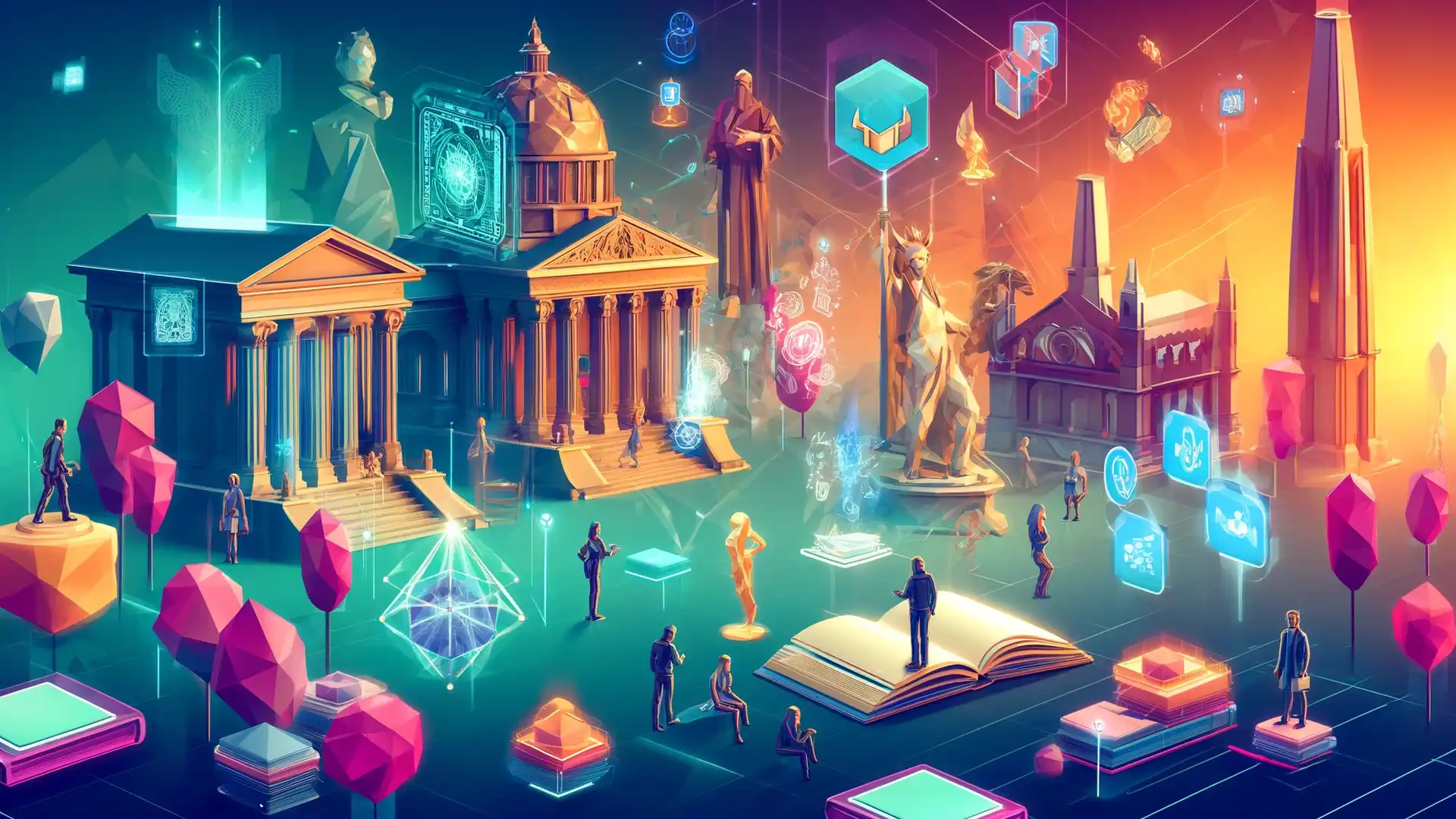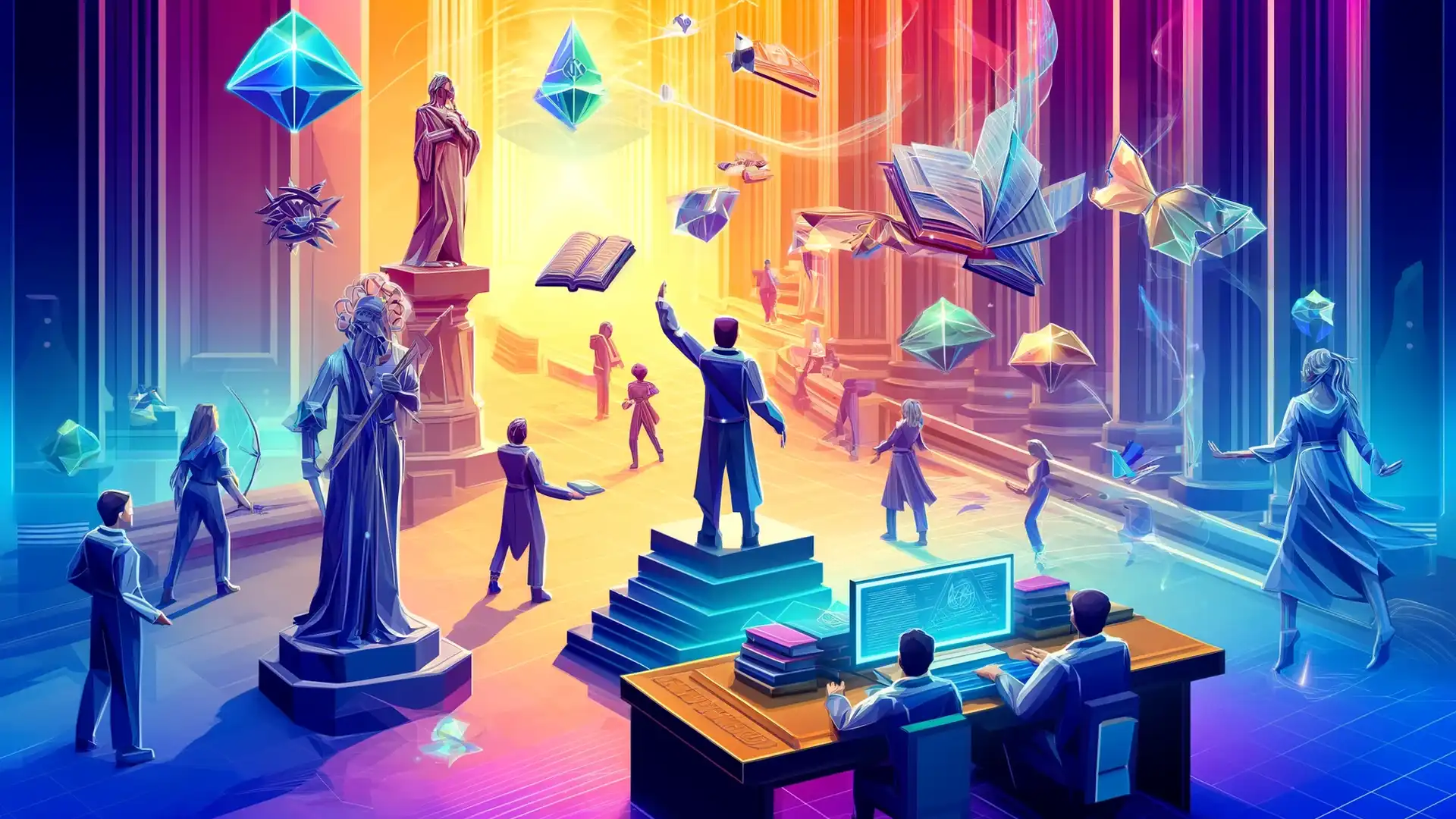Designing Educational NFT Credentials: Ideas, Best Practices, and Examples

 Author:
Artem Grigoriev
Author:
Artem Grigoriev
Crafting Secure and Innovative Educational NFT Credentials
Imagine a world where your academic achievements are not just documented on paper . They are embedded in a secure, unique, and interactive digital token. This chapter delves into the exciting realm of educational NFT (Non-Fungible Tokens) credentials. It showcases a transformative approach that leverages the robust features of blockchain technology. This method provides students and educational institutions with immutable (unchangeable) and reliable records of achievement. These digital credentials are more than mere digital copies of traditional paper certificates. They represent a significant advancement in security, transparency (openness and clarity), and accessibility .
📘 This article complements: "The Complete Guide to NFT Credentials". Explore it to find answers to all your questions;)
Leading experts suggest that this technological innovation could revolutionize how educational achievements are viewed, valued, and verified globally . It potentially increases trust and acceptance among employers and educational institutions worldwide.
Educational NFTs are transforming the issuance, storage, and verification of academic credentials. By encoding academic achievements onto a blockchain (a secure, decentralized digital ledger), each credential becomes a unique digital asset. It is tamper-proof (cannot be altered fraudulently) and permanently verifiable. This feature ensures that these credentials cannot be falsified or lost. It significantly reduces the risks of forgery and loss. This is particularly crucial at a time when educational fraud and document tampering are major concerns.
The solid nature of blockchain technology ensures that each credential is embedded in a system that promotes trust and reliability , crucial for maintaining the integrity of educational qualifications. Benefits of Blockchain in Reducing Fraud
The strength of these credentials lies in their capacity to not only streamline processes but also enhance the educational experience for students. They offer a dynamic interface (an interactive platform) where students can engage with their academic records and observe updates in real-time as they achieve new milestones. This system fosters more interaction with educational pathways. It transforms credentials from static documents into a live, evolving record of a student's academic journey. A study from Stanford University shows that interactive academic platforms significantly increase student engagement and academic motivation. They enhance learning outcomes and personal development.
💡 Note: The role of blockchain in educational NFTs is critical. It ensures that each credential is securely stored and remains accessible only to authorized individuals. It enhances both privacy and data integrity.

Technologically, implementing NFTs for educational purposes demands careful selection of blockchain protocols. They ensure low transaction costs (minimal fees for processing transactions) and high transaction throughput (the capability to handle many transactions quickly). These features are essential for managing the numerous inquiries and updates typical in educational settings. For example, platforms like Ethereum, with its transition to proof-of-stake (a more energy-efficient method of processing transactions), provide scalability (the ability to support growth) and reduced energy consumption. They are suitable for widespread institutional adoption. Ethereum's Move to Proof-of-Stake
Moreover, the potential of NFTs extends beyond simple credentialing. Through the innovative use of metadata (additional details that provide more context), these tokens can incorporate extensive information about courses, extracurricular activities, and more. Metadata in this context not only enriches the credential itself. It also presents a fuller picture of a student's educational accomplishments, including non-academic achievements that are often overlooked. This comprehensive approach can help create a more detailed and expansive portfolio for students. It is essential during job searches and career advancement.
However, transitioning to NFT-based credentialing presents challenges, including data privacy and the need to comply with global education standards. Solutions involve the use of advanced encryption methods (techniques to secure digital data). They also ensure that NFT platforms conform to international regulatory frameworks. These measures are crucial to preserve the integrity and privacy of student data. Leading educational institutions and regulatory bodies are actively examining these issues. They aim to facilitate a smooth transition to digital credentialing systems and to address potential obstacles to their adoption and integration.
Leading educational institutions have begun to experiment with NFT credentials. They provide valuable case studies that illustrate both the potential and the challenges of this technology. These examples serve as benchmarks for others. They offer insights into best practices and practical considerations for incorporating blockchain into educational frameworks. The experiences gained from these pilot projects are vital for refining the technology and its applications in education.
As we look to the future, the trajectory of educational technology indicates a shift towards more personalized and lifelong learning models. NFTs could become a key component of these models. They enable a more interactive and enduring record of learning achievements. Their ability to securely and transparently document and verify academic records sets the stage for a future where learning is more personalized, continuous, and closely aligned with individual career paths and lifelong goals.
💡 Tip: For educators and technologists considering NFT credentials, it is crucial to focus not only on the technological implementation. Also focus on how these tools can enhance the educational experience for students. Ensure that the technology supports and improves learning rather than merely digitizing existing processes. This approach will maximize the benefits of NFTs and foster a deeper connection between education and technological innovation.

Best Practices and Future Outlook for NFTs in the Expanding Realm of Digital Education
In the rapidly growing field of digital education, NFTs (Non-Fungible Tokens) are emerging as a powerful tool. They are transforming how educational credentials are created, managed, and used effectively. This chapter explores the strategic implementation of NFTs within the education sector. It focuses on establishing best practices that ensure these digital assets are secure, scalable, and significantly enhance the educational experience . A comprehensive report by Deloitte highlights the transformative role of blockchain technologies like NFTs. It streamlines operational efficiencies and enhances data veracity (accuracy and reliability) across the educational spectrum. This contributes to a more fluid and dynamic approach to managing educational processes.
Various prestigious universities and innovative online platforms have pioneered the use of NFTs in education. They demonstrate significant benefits in terms of student engagement and the reliable verification (confirmation) of learning achievements. These case studies are critical references. They provide insights into effective strategies for deploying NFT credentials. They emphasize the importance of designing systems that are not only technologically proficient but also focused on the students. These digital credentials fully support and enrich educational goals.
Recent initiatives by esteemed institutions like MIT and Harvard exemplify the successful integration of NFTs . They manage and secure academic records, and establish a standard in the educational field. These examples offer valuable lessons on the utility and impact of NFTs in real-world educational settings, making them essential models for others in the sector.
A crucial aspect of implementing NFTs in education is the security of sensitive student information. This involves adopting strong cryptographic techniques, such as hash functions (a method for creating a unique, fixed-size identifier from data) and public-private key encryption (a method of securing data using two related keys). These techniques safeguard data integrity and privacy. They create a trusted environment where digital credentials can thrive without the risk of fraud or breaches. According to leading cybersecurity experts, the incorporation of such advanced encryption methods significantly reduces vulnerabilities. It fosters a safer digital educational landscape .
In addition to security, significant legal, regulatory, and ethical challenges must be considered. Institutions must navigate complex landscapes like GDPR (General Data Protection Regulation) in Europe and FERPA (Family Educational Rights and Privacy Act) in the USA. They ensure all digital credentials comply with stringent data protection laws. Managing digital rights and maintaining ethical standards are also pivotal. This underscores the need for a careful, considered approach to NFT implementation. Navigating GDPR and FERPA in Digital Education
💡 Note: The integration of advanced cryptographic methods is essential for protecting digital credentials and maintaining the trust of all stakeholders involved.

Technologically, the foundation of any NFT system in education relies on interoperable blockchain platforms and specific token standards, such as ERC-721 and ERC-1155. These technologies enable the unique identification and seamless transfer of credentials. They integrate smoothly with existing educational IT infrastructures. This provides a cohesive and user-friendly experience. It ensures that NFTs can be widely adopted across educational systems without significant disruptions. Extensive modifications to existing digital ecosystems are not necessary.
However, the adoption of NFTs faces challenges, including the digital divide, which remains a significant barrier. It could exclude underserved communities from accessing these innovative educational tools. To combat this, solutions like mobile-first strategies and collaborations with telecommunications companies are crucial. They broaden access and ensure inclusivity across diverse populations. By addressing accessibility issues, educational institutions can use NFTs to enhance equity in education . They provide opportunities for all students, regardless of their socio-economic background.
The future of NFTs in education appears highly promising, with potential shifts toward micro-credentialing and lifelong learning records. These trends suggest a more flexible, modular approach to education. Learning achievements are continuously compiled and verified, supporting career development and personal growth over a lifetime. This shift could lead to education systems that are more tailored to individual needs and life stages. They offer a more personalized and adaptable learning journey.
Emerging technologies such as AI (Artificial Intelligence) and machine learning could further enhance NFT-based educational systems. They automate processes and personalize learning experiences. This could lead to a more adaptive educational framework, responsive to individual student needs and learning styles. It could potentially increase the effectiveness of educational programs and student satisfaction.
In conclusion, as we explore the intersection of NFTs and education, it is clear that these digital assets hold the potential to revolutionize educational systems. They provide secure, verifiable, and engaging learning experiences. NFTs pave the way for a future where education is more accessible, customizable, and aligned with the digital age. As such, continuous research and development in this field are crucial. They ensure that the deployment of educational NFTs meets the evolving demands of learners and educators alike, driving forward innovation in education technology.
💡 Tip: Institutions looking to implement NFTs should consider not only the technological and regulatory aspects but also the broader implications on student access and equity. Emphasizing inclusivity and support for all learners will be key to the successful integration of NFTs in educational contexts. By prioritizing these factors, educational institutions can ensure that the benefits of digital transformation in education are widely distributed, contributing positively to the educational ecosystem.

Developing a Curriculum Using NFT Credentials and Blockchain
Challenges and Limitations of NFT Credentials in Education
Why Not All Educational Institutions Have Adopted NFT Credentials Yet
NFT Credentials Accessibility: Making Education Open to All
NFT Credentials and Lifelong Learning: Best Practices
